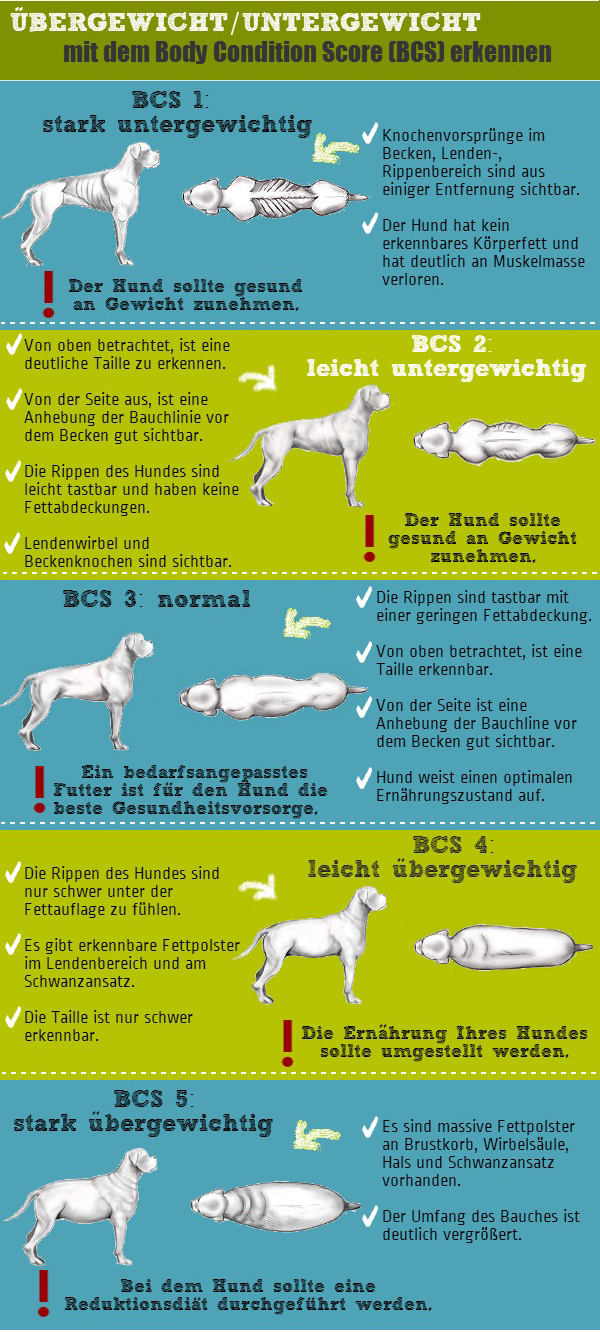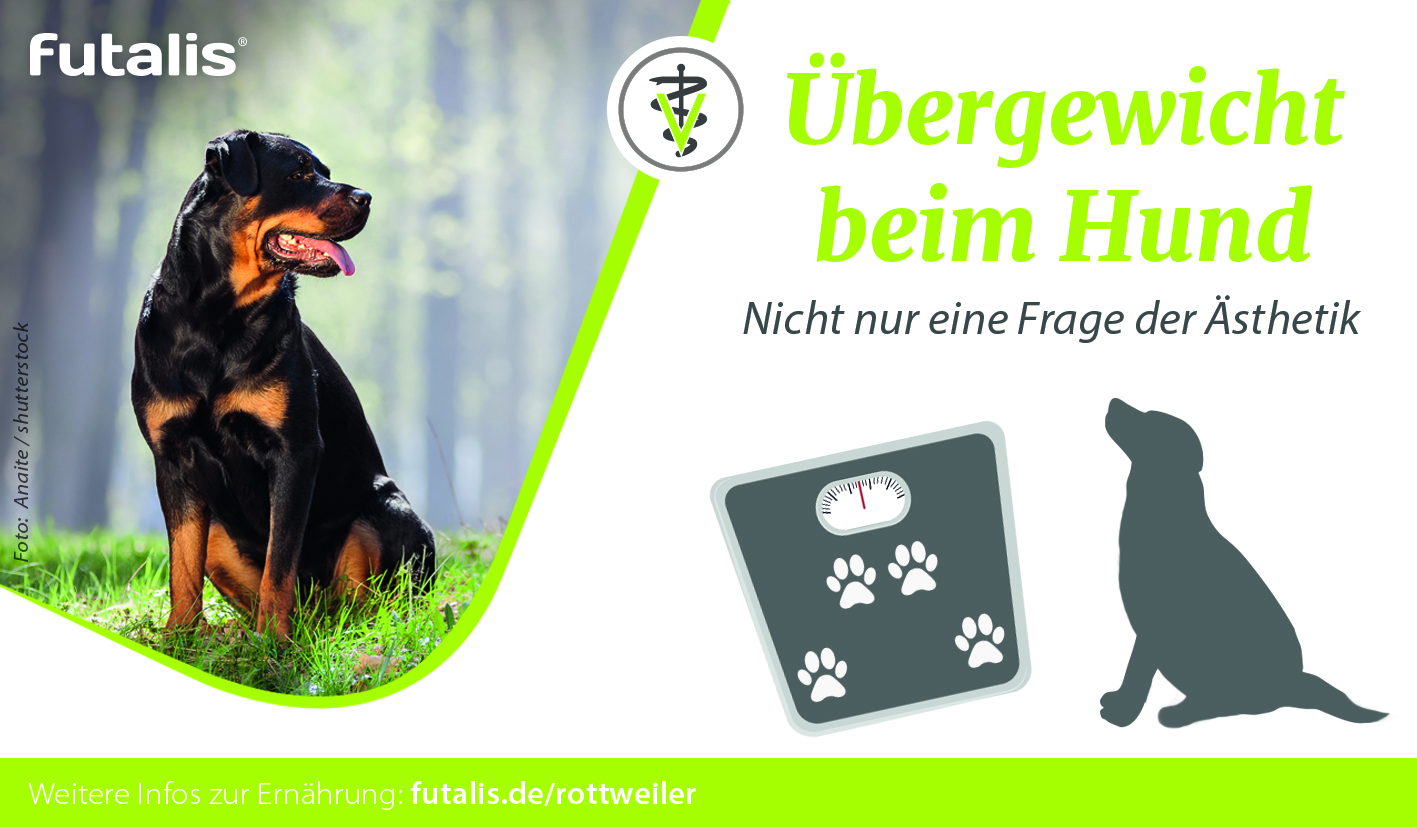The number of overweight dogs is constantly increasing. According to studies, between 25 and 40 % of all dogs in Germany are now overweight. Unfortunately, this is not only an optical problem, but also a health problem. You can find out here why a half-filled bowl is not enough and what you can do about the excess pounds.
Is my dog just a little strong or does he have a problem?
It is often difficult for dog owners to recognise whether there is already a health problem or whether their Rottweiler still has an acceptable nutritional condition. Here the classification according to the so-called Body Condition Score, an objective scale used uniformly by veterinarians, can help. Here different body regions are evaluated optically and palpatorically. Ideally, a belly line rising from the ribcage to the groin should be visible when looking at the dog from the side and a clear waist should be visible from above. The ribs, vertebral processes and pelvic bones should be easily palpable without increased fat deposits.
Also the absolute weight in comparison to the breed standard can be used as an aid for the determination of the overweight. Here, however, individual differences must be taken into account. An overweight of 10 % is referred to as incipient obesity, an excess of 20 % is referred to as manifest obesity. Let us take the Rottweiler bitch Bella as an example: she currently weighs 49 kg, but 42 kg would be ideal for her. The actual weight deviates by 17% from the ideal weight. In this case it is a disease that should be treated for the benefit of the animal.
Causes - Why does my dog weigh too much?
The cause of overweight is ultimately always an energetic oversupply of the animal. This excess energy is stored in the body as fatty tissue. One reason for this can be, for example, a change in the energy requirement. Thus the energy requirement of older dogs decreases in the course of their life by up to 20%.
In addition, the dog breeds differ in their maintenance needs. Some animals also show a hormone-induced increased feed intake after castration, and also metabolic diseases (hypothyroidism or hyperadrenocorticism) or the influence of medication can influence the energy requirement and feed intake. However, the decisive factor for weight gain in dogs is the human being; more precisely, the feeding behaviour of the owner. Especially the social aspect of feeding has proven to be problematic in scientific studies. Additional treats are often not considered by the owners as actual feed intake, although these supposedly small additions can easily increase the animal's energy intake many times over.

Health risks as a result of obesity
It is important to recognise that obesity is a disease that can also cause other health problems. Being overweight increases the risk of cardiovascular disease, diabetes mellitus, tumours or musculoskeletal disorders. A study with 48 retrievers from 2002 (Kealy et al., J Am Vet med Assoc., 220/9) has also shown a 20 % reduction in the life expectancy of overweight dogs. For the sake of the dog's health, dog owners should therefore strive for weight reduction measures in good time.
Slimming with the help of a reduction diet
Ideally, a feed should cover 100% of both the energy requirement and the requirement for other nutrients such as proteins, minerals and vitamins. In order to achieve the desired weight reduction, the energy supply must be limited. If, according to the principle "FDH" (eat half), which is popular with humans, the usual amount of food is simply reduced, there is inevitably an undersupply of the other nutrients and the risk of the dog becoming ill increases.
To lose weight, it is rather necessary to choose a food with a different composition. The energy density should be reduced and the ratio of ingredients should be optimized. In order to determine the need values, one counts best with the ideal weight of the dog: With our Rottweiler Bella, with her current 49 kg and an ideal weight of 42 kg, the energy requirement for a 42 kg heavy dog must first be calculated (= 8.3 MJ ME). However, Bella may only receive 60% of this (= 5 MJ ME) in order to get the remaining energy from the existing fat reserves and thus reduce them. The addition of proteins and other nutrients, however, remains unrestricted. The calculation, however, refers to the 42 kg ideal weight and not to the actual mass of the dog (the excess fat tissue does not create any additional need).
A suitable food has a high crude fibre content to reduce the energy density, which is often achieved by adding cellulose. The energy content should be between 10 and 13 MJ ME/kg dry food. The crude protein content is also usually higher than in standard feed. This nutrient combination has proven effective in combating overweight. Caution is advised with products labelled "light". As a rule, these are feedstuffs which are unsuitable for the reduction diet.
A healthy diet is important for the well being of the dog.
It is important that owners set a healthy and realistic time span for their dog's weight loss. The optimum reduction in body weight is about 1-1.5% per week. In this case, Bella would need about 10-15 weeks to reach your ideal weight. During this period it is also advisable to record the weight and the course of the diet on a weekly basis. This makes it easier to assess success and motivates you to stay on the ball.
Exercise - Fighting overweight through activity
In addition to an appropriate diet, the activity level of the dog can also influence weight development. An active everyday life increases the animal's energy requirements and thus supports the reduction of excess fat.
Nevertheless, it should be borne in mind that only after a considerable increase in physical exertion does a significant increase in energy demand occur. Only from two and a half hours of daily exercise would the energy consumption increase by about 20% (depending on the type of exercise). Here it must be considered that overweight dogs usually already have physical limitations, such as joint problems or cardiovascular diseases, which stand in the way of excessive stress. Here it can prove to be advantageous to fall back on physiotherapeutic movement programs.
Staying healthy: Maintaining weight and prophylaxis
If the dog owners have succeeded in reaching the ideal weight after a successful reduction diet, they should switch back to a food that is adapted to their needs. It is important to have a controlled diet that is supported and controlled by regular weight controls. From now on all offered food components, i.e. staple food, additives and treats, must be included in the ration design in order to avoid an energetic oversupply.


